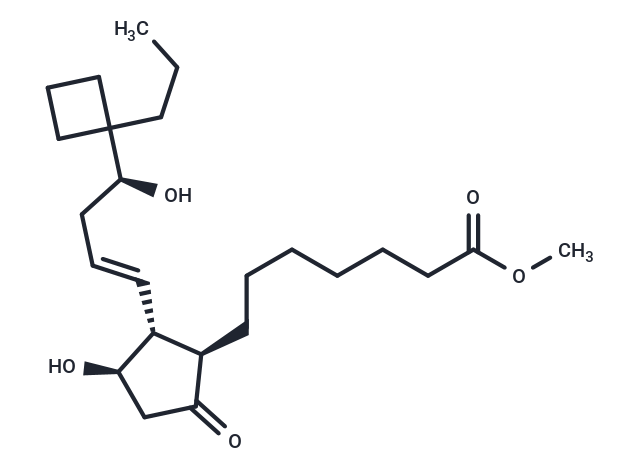Shopping Cart
- Remove All
 Your shopping cart is currently empty
Your shopping cart is currently empty
Butaprost is a chemical compound that functions as a selective agonist for the prostaglandin E receptor (EP2). It exhibits an EC50 of 33 nM and a Ki of 2.4 μM when interacting with the murine EP2 receptor. However, Butaprost demonstrates lower activity against murine EP1, EP3, and EP4 receptors. Furthermore, it effectively attenuates fibrosis by inhibiting the TGF-β/Smad2 signaling pathway [1] [2] [3].

| Pack Size | Price | Availability | Quantity |
|---|---|---|---|
| 500 μg | TBD | 35 days | |
| 1 mg | TBD | 35 days | |
| 5 mg | TBD | 35 days | |
| 10 mg | TBD | 35 days |
| Description | Butaprost is a chemical compound that functions as a selective agonist for the prostaglandin E receptor (EP2). It exhibits an EC50 of 33 nM and a Ki of 2.4 μM when interacting with the murine EP2 receptor. However, Butaprost demonstrates lower activity against murine EP1, EP3, and EP4 receptors. Furthermore, it effectively attenuates fibrosis by inhibiting the TGF-β/Smad2 signaling pathway [1] [2] [3]. |
| In vitro | Butaprost, at concentrations ranging from 1-100 nM over a period of 0.5-24 hours, significantly enhances Nur77 mRNA expression by approximately five-fold in hEP2-HEK293/EBNA cells, showing both dose- and time-dependency. The augmentation of Nur77 gene expression is mediated via the PKC pathway. Additionally, at a concentration of 50 μM for 24 hours, Butaprost mitigates TGF-β-stimulated fibronectin expression, Smad2 phosphorylation, and the epithelial-mesenchymal transition in Madin-Darby Canine Kidney (MDCK) cells. Western Blot analysis of HEK 293/EBNA cells, which stably express the human EP2 receptor, corroborates the five-fold increase in Nur77 mRNA expression after exposure to Butaprost. |
| In vivo | Butaprost treatment (1-4 mg/kg; intraperitoneal injection; twice daily; for 7 days) effectively attenuates fibrosis development in male C57BL/6 mice (8 weeks of age; 21 g) subjected to unilateral ureteral obstruction surgery. This outcome is evidenced by the decreased gene and protein expression levels of α-smooth muscle actin, fibronectin, and collagen 1A1, indicating a significant mitigation of fibrosis. |
| Synonyms | TR-4979, Butaprostum, (R)-Butaprost |
| Molecular Weight | 408.57 |
| Formula | C24H40O5 |
| Cas No. | 69685-22-9 |
| Storage | Powder: -20°C for 3 years | In solvent: -80°C for 1 year | Shipping with blue ice/Shipping at ambient temperature. |

Copyright © 2015-2025 TargetMol Chemicals Inc. All Rights Reserved.